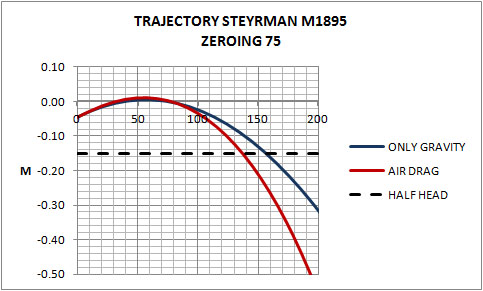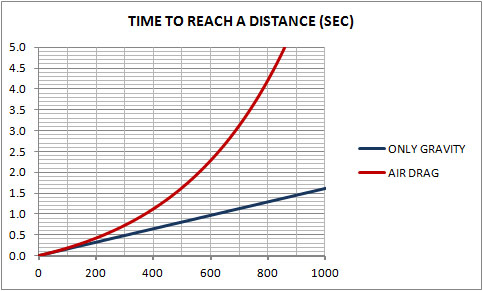Original: Consequences of BF1 air drag for players posted September 24th, 2016
Author: Leptis
In other threads the air drag model and the algorithm used are discussed.But that’s just interesting (and fun) for nerd math lovers, not for the common player. Since the algorithm is more accurate (4th approach) we can obtain some general conclusions.
Here you can see the trajectories (all graphics correspond to STEYRMAN M1895 the slowest single action rifle) with only gravity (BF4) and air drag (BF1) (same features V, g, etc… in both cases):
As it assumed, the bullet drop is much greater in BF4. Gravity=-12 m/sec2 is applied to only gravity, so the diferencial effect is due only to air drag. Note that the trajectory with air drag finish at 857 m. (cause later).
Seeing in detail what happens at close range:

A half head size (15 cm.) is shown. This is because if you aim directly at the center of the head (30 cm high), the shot will be a headshot up to the trajectory crosses the line -0,15. That’s a way to measure the ballistic accuracy.
No significant difference up to 100 m and it will be a headshot up to 135 m, shorter range than gravity model. Compensation is needed closer than in the gravity model.
If you want to avoid the compensation you can adjust the zeroing to other distance. But…what range of validity that new adjustment has?

As you see (zeroing 300m), it is only valid (without compensation) between 290 and 310 m. A very, very narrow window of validity.
Only as a reference here you have the range of validity of adjustements for SRR-61 in BF4 zeroing 100 and zeroing 300 (Ok! I know it was a extreme weapon!).
Well…How easy it is to compensate the drop?.Here is the trajectory as seen through the scope measured as the angle in radians (that we could convert into dots knowing the optical characteristics of the scope … if the scope had dots on the crosshair!!!).
It can be seen that while compensation in BF4 was totally linear (the same number of dots per additional 100 m), in BF1 is highly nonlinear. Difficult to calculate intuitively. Despite that, up to about 300 m (with zeroing 75) a proportional and approximated rule can be used.
The importance of that is you can develop a skill to compensate intuitively with linear compensation, but it is very difficult to do that with nonlinear processes (the human brain doesn’t work in that way).
And what about time? (because we have been speaking about drop/distance). That is one of the most important effects. Here you see time to reach a distance:

A huge difference. To hit a target at 800 m would need about 4 sec of bullet flight. An eternity. This question of time is very important regarding the probability to hit a moving target.
Additionally there is another counterintuitive aspect. The advancement of sight to hit a moving target in BF4 was constant (Yes. Many players do not know that the advancement of sight for a moving target moving perpendicularly to the aiming line is always a constant regardless of the distance). In BF1 due to non nonlinearity is a variable quantity depending on the distance. Hard to develop the necessary skill.
Finally … what is the maximum distance that can be reached?. In this case the TimeToLive of bullet operates due to the slowdown of the bullet (in BF4 the TimeToLive allows the bullets left the map.
Here the maximum range of the rifle in the TimeTo Live= 5 sec. It is 857 m ( for GEWERH 98 it is 980 m)

In any case… have you a scope with 12 degree of field of vision and magnification enough to see a target at 800 m?. If not, the compensation will be out of scope.
If you add that you haven’t rangefinder and the scopes (at least the ones I’ve seen) haven’t dots… calculations are not useful at range.
The conclusions for fast weapons (600 m/sec or more) with default zeroing (conventional distances) are:
0-150 m: You are not going to feel any differences with the BF4 ballistic. Just aim and shot. Forget air drag (and drop).
150-300 m: An intuitive skill can be developed to compensate the drop, but not easy.
300-600 m: Very difficult compensation.You don’t know the distance and compensation will seem erratic (nonlinear).
600-900 m: Virtually impossible to secure a shot. Just lucky shots… if you see the target in the scope…and the target don’t move.
The general conclusion is DICE want to avoid the hill campers and long-range sniper “squeezing” players into a smaller range of play distances because at those distances the effect of air drag is negligible.
Bad news long-range snipers!!!
P.S.: Always you have the classic “two shots” method: Shoot a nearby rock or wall, estimate the drop and compensate with that measure. Beside problems of time and field of vision.



